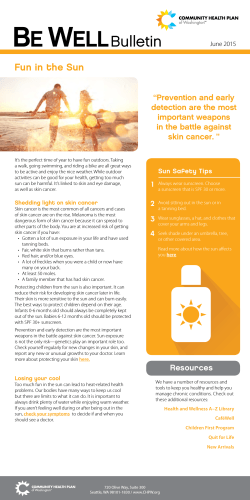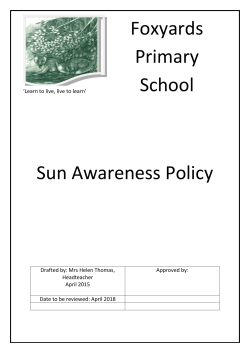
Jul Health Smart Newsletter
H E A L T H FREE • Take One July 2015 Stay Safe in the Sun! SPF Know Your Numbers WHAT’S INSIDE Try These Tips for Summer Fun! Lyme Disease: Protect Your Family This Summer Can’t Relax? De-Stress with Deep Breathing 2 3 4 Sunscreens protect your skin by absorbing and/or reflecting UVA and UVB rays. The U.S. Food and Drug Administration requires that all sunscreens contain a Sun Protection Factor (SPF) label. The SPF reveals the relative amount of sunburn protection that a sunscreen can provide an average user (tested on different skin types) when correctly used. as well. These “broad-spectrum” sunscreens are highly recommended. UVA rays penetrate deep into the skin and heavily contribute to premature aging. UVB rays mostly affect the surface of the skin and are the primary cause of sunburn. Sunscreens with an SPF of at least 15 are recommended. You should be aware that an SPF of 30 is not twice as protective as an SPF of 15; rather, when properly used, an SPF of 15 protects the skin from 93% of UVB radiation, and an SPF 30 sunscreen provides 97% protection. —Source: U.S. Environmental Protection Agency Although the SPF ratings found on sunscreen packages apply mainly to UVB rays, many sunscreen manufacturers include ingredients that protect the skin from some UVA rays Senior Health Update Are You Setting Yourself Up for a Fall? Kids’ Health Update Try These Tips for Summer Fun! Have you ever tripped while walking down the stairs? Slipped on a rug? It may seem silly, but falls are nothing to take lightly. Here are some easy tips to help fall-proof your home: ■ Keep electrical cords out of walking paths. ■ Securely fasten carpet, rugs and carpet runners to the floor. ■ Keep walkways and stairways free of clutter. ■ Use non-slip mats in the bathtub or shower. ■ M ake sure you have enough lighting in each room, at entrances, and on outdoor walkways. Use light bulbs that have the highest wattage recommended for the fixture. — Sources: National Institutes of Health; Mayo Clinic You say school has been out for a month now, and the kids are hanging around the house staring at screens of all kinds just a bit too much? It’s time to recharge! Try these tips to get your family eating, moving and enjoying the summer in a healthier way. ■ H ave fun in the sun! Play outdoors during morning and evening hours to avoid heat exhaustion. Don’t forget the sunscreen. ■ Eat a healthy breakfast every morning, then go for a swim, hike or bike ride. ■ A dd seasonal produce to your family’s meals. Make half of their plates fruit and vegetables. ■ L imit screen time on TVs, computers and hand-held devices. Take crafts outdoors. Jump rope or play hopscotch or kickball. Take your kids to a local park or walking path to increase their active time in the summer. ■ H elp your kids drink plenty of fluids. Choose water or low-fat milk instead of sugary drinks like soda. — Source: National Institutes of Health Your Healthy Feet — What Is Toenail Fungus? Toenail fungus is an infection of the nail and sometimes the surrounding tissue. It’s common, with 20% of the general population and 75% of individuals over 60 years old affected. Frequently the problem causes cosmetic concerns, but many patients also experience pain. Sometimes toenail fungus can allow more serious infections to occur. Most patients note yellowing and thickening of the nail. The nail may become brittle with jagged edges, become deformed or detach from the nail bed. Risk factors include increasing age, being male, or having certain medical conditions such as diabetes or vascular insufficiency and malnutrition. Fungus grows well HEALTH smart July 2015 2 in warm, moist environments such as showers. Diagnosis is made based on a doctor’s exam and can be confirmed by viewing scrapings of the nail under a microscope or growing the fungus in a culture medium. Debridement of the nail can be performed to relieve pain without directly treating the fungus. Both local and systemic treatment options are available, but are of limited effectiveness. Your doctor can explain treatment pros and cons. — S ource: American Orthopaedic Foot & Ankle Society Lyme Disease Protect Your Family This Summer Although anyone can get Lyme disease, children spend a lot of time outdoors in the summer and are at particular risk. Reasons to suspect that your child may have Lyme disease include: your family lives in or has visited a region where Lyme disease is commonly found; you know or suspect that your child has been exposed to ticks; your child is experiencing symptoms such as rash, fever, chills, fatigue, joint or muscle pain, or facial paralysis. Children sometimes experience joint pain as their first, and possibly only, symptom of Lyme disease. If you suspect that your child may have Lyme disease, seek care promptly. If the doctor thinks that your child has Lyme disease based on symptoms and possible exposure, your child will most likely receive antibiotics for two to four weeks. If your child’s symptoms are not clear-cut, the doctor may decide to have your child’s blood tested. Keep in mind that blood testing is more accurate the longer the child has been infected. A blood test for Lyme disease may not appear positive until two to three weeks after infection. Therefore, a doctor may order a later, second test if the first test was negative. Skin Cancers Know the Differences Basal-cell and squamous-cell cancers are the most common skin cancers. Both are found mainly on parts of the body exposed to the sun, such as the head and neck. They are strongly related to sun exposure. They are much less likely than melanomas to spread to other parts of the body and become life threatening. Still, it’s important to find and treat them early. If left alone, they can grow larger and invade nearby tissues and organs, causing scarring, deformity or even loss of function in some body parts. — Source: Centers for Disease Control and Prevention Melanomas are cancers that develop from melanocytes, the cells that make the brown pigment that gives skin color. Melanocytes can also form non-cancerous moles. Melanomas can occur anywhere on the body, but are more likely to start in certain areas. The trunk is the most common place in men. In women, the legs are the most common site. The neck and face are other common places. Melanomas are not as common as basal-cell and squamous-cell skin cancers, but they can be far more serious. Melanoma is almost always curable in its early stages. But if left alone, it is much more likely to spread to other parts of the body, where it can be very hard to treat. DID YOU KNOW? It’s Time to S-T-R-E-T-C-H! Stretching can help improve flexibility, and, consequently, range of motion in your joints. Better flexibility may improve your performance in physical activities or decrease your risk of injuries by helping your joints move through their full range of motion and enabling your muscles to work most effectively. Stretching also increases blood flow to the muscles. And you may come to enjoy the ritual of stretching before or after hitting the hiking trail, the dance floor or the soccer field. Stretch every day for better health. It feels great! Getting regular skin checks is important so that any problems can be caught and treated early. — Source: Mayo Clinic — Source: American Cancer Society 3 HEALTH smart July 2015 HEALTH MART IS YOUR LOCALLY OWNED COMMUNITY PHARMACY We offer all the benefits of national chains with the highly personalized care you expect from a family-run business. See how we’re making a real difference every day. www.healthmart.com/healthmartbrand PLAN ACCEPTANCE Health Mart pharmacies honor nearly all prescription plans at the same co-pay as the national chains, and our pharmacists are always here to answer any questions you have about your medications. Your Health. Your Choice. Our Brand. DEDICATED SERVICE Our pledge to you: care, quality, value, expertise and dedication. EVERYDAY SAVINGS Because your locally owned, award-winning, customer servicefocused Health Mart is part of a nationwide network of community pharmacies, you will find everyday low prices on all prescription and over-the-counter products. Not only does your Health Mart pharmacy have the brand names you want, it also offers a wide range of generics and over-the-counter products, including the best selection of Health Mart brand products. Let’s Move! Stay Active — Safely — During July’s Hottest Days July means days at the pool, family picnics, baseball and other outdoor activities. Here are some tips to keep your family physically active in the warmer months: ■ H ydrate. Drink plenty of water before, during and after physical activity to avoid dehydration. Can’t Relax? De-Stress with Deep Breathing Deep breathing is a relaxation technique that involves using the lungs and the abdomen or diaphragm. Most of us take shallow breaths from our upper chest instead of using our diaphragm. Shallow breathing limits the amount of oxygen we take in, and when we are stressed our breathing becomes even more shallow. This makes us feel more tense and anxious. Deep breathing encourages full oxygen exchange throughout the chest and lungs, which calms the mind and the body. Directions: 1. Sit comfortably with your back straight. Put one hand on your chest and the other on your stomach. HEALTH smart July 2015 2. B reathe in through your nose. The hand on your stomach should rise. The hand on your chest should move very little. 3. E xhale through your mouth, pushing out as much air as you can while contracting your abdominal muscles. The hand on your stomach should move in as you exhale, but your other hand should move very little. 4. C ontinue to breathe in through your nose and out through your mouth. Try to inhale enough so that your lower abdomen rises and falls. —Source: Des Moines University 4 ■ R espect the sun. Wear wide-brimmed hats, use water-resistant sunscreen with at least SPF 15, and reapply it every two hours. Avoid intense activities between noon and 3 p.m. when the sun is at its strongest. ■ D ress for the heat. Wear lightweight, light-colored clothing plus sunglasses. ■ H ead indoors. When the heat gets unbearable, try indoor activities at your local YMCA or rec center, such as basketball, swimming, yoga or racquetball. —Source: American Heart Association Health Mart’s Health Smart newsletter is not intended as medical, legal or regulatory advice. The information provided is intended to educate and inform. Please consult with your physician or other licensed professional for advice. Health Mart and its affiliates and member pharmacies disclaim all liability arising from or related to reliance on information contained in Health Mart’s Health Smart newsletter.
© Copyright 2025











